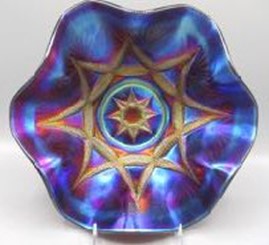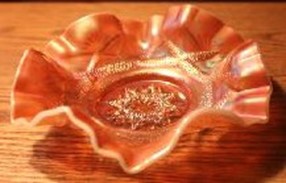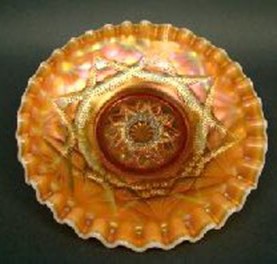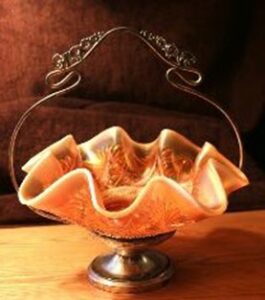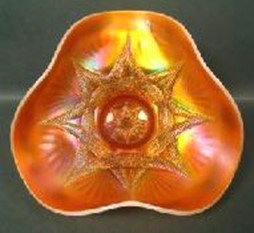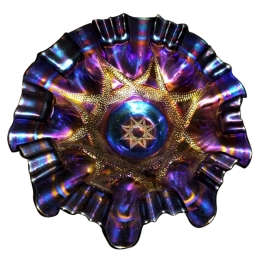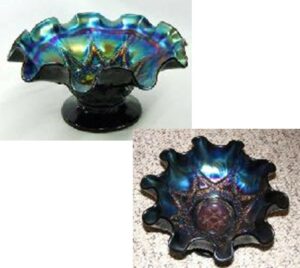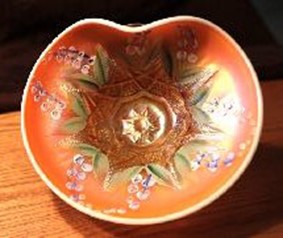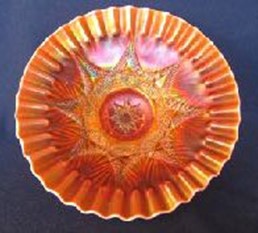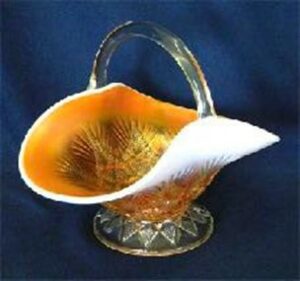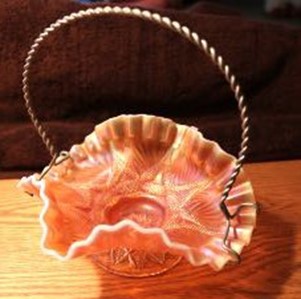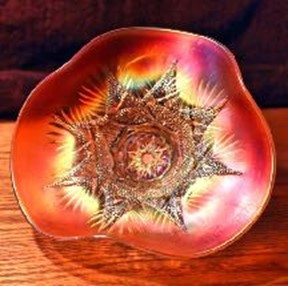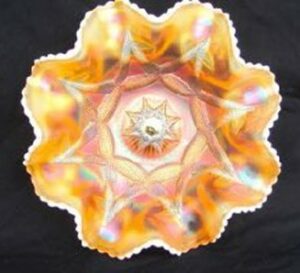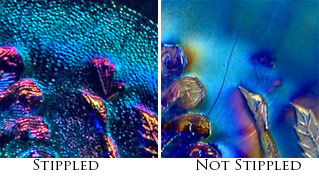Dugan’s Ski Star
By Dr. Larry Keig
Imaginatively designed, on face and underside alike, Ski Star was produced by the Dugan Glass Company for only a few months, in 1910 and 1911. But within that narrow time frame, it was made in immense quantities and in a host of captivating shapes and edge treatments.
The primary pattern is comprised of two stippled eight-point stars, each formed from interlocking waning crescents. A massive star subsumes most of the expanse. A diminutive star is placed dead-center.
The secondary pattern on all but a small fraction (99 percent or more) of Ski Star pieces is Compass. A striking geometric, it is an intaglio pattern that looks like it was sculpted and polished from marble. The exterior pattern on a small number of large Ski Star bowls is Jeweled Heart.
Colors and Effects
The color field is limited, characteristic, as would be expected, of the early carnival years at Indiana, Pa.: peach opal, amethyst/purple, oxblood, and marigold. Peach opal is far and away the most prevalent. Amethyst and purple are somewhat harder to find, oxblood even more difficult. Marigold is available, in infinitesimal amounts.
Blue is said to exist but no items in this color have been reported as having sold. It’s unlikely that Ski Star in this color was made, because Dugan’s cobalt carnival was not put on retail store shelves until late summer 1912. What has been reported as cobalt Ski Star is probably amethyst or oxblood with electric blue iridescence.
Surface color and iridescence can be breathtakingly beautiful, good enough, or downright dreadful. On peach opal, surface color ranges from burnt orange to autumn pumpkin to sunny mandarin to ripe cantaloupe to pale, often “washed out” peach. Iridescence runs the gamut from multicolor (aquamarine, canary, lavender, pink, rose, and/or tangerine) to flat, with no more than orange (or, worse, peach) overlay on the clear glass base.
Iridescence on the amethyst and oxblood can be stunning, the electric and multicolor exceptionally vibrant. It can also be less colorful but is rarely repugnant, the anomalous god-awful gun metal notwithstanding. Surface color and iridescence and surface effects of the marigold will be discussed later on.
The background surface is usually satiny, but can also be glossy or stretchy. The stretchy are especially eye-catching when fulgently iridized.
Dugan’s Ski Star and Millersburg’s Fleur-de-lis share the unusual distinction of having been produced in both collar-base and dome-foot versions. These patterns also share the distinction of having intricate near-cut backs. (Ski Star, as will be noted, also comes with an a stylized, non- geometric secondary.)
Too little attention has been paid to differences in appearance and availability of collar-base and dome-footed Ski Star. Knowing the differences is a key to understanding what’s easy to get hold of and what’s tough to come by.
Collar-Base Ski Star-Compass
Collar-base Ski Star-Compass pieces were made from two molds in an extensive assortment of shapes and edge treatments. The large items have a base diameter of four inches, the small a three-inch base. All collar-base Ski Star-Compass pieces, even the tightly crimped, have a smooth, non-serrated edge. All shapes and edgings appear to be available in peach opal. The same cannot be said for the amethyst and oxblood.
Bowls. Bowls are the most easily found shape. The most frequently seen large item is the broadly-ruffled in peach opal. Its amethyst and oxblood counterparts, though seen less often, are not difficult to track down. Six- and eight-ruffled, these bowls have top diameters that range from 10 to 11 inches. The other shapes and edge treatments are seen far less often. Illustrated is Neal Becker’s spectacularly iridized broadly ruffled oxblood.
The only small bowls that turn up regularly are the peach opal, amethyst, and oxblood six and eight broadly-ruffled. Small bowls in other shapes and edgings—e.g., ruffled and tightly-crimped and tri-corner with tightly crimped or non-crimped edges—are seen far less often. The six-ruffled with tightly-crimped edge, photographed by Diane Highnam, is an attractive and seldom seen Ski Star shape.
Berry Sets. Complete berry sets, composed of a broadly ruffled master and six similarly-shaped serving-size bowls, sometimes surface in peach opal. These usually bring modest sums when sold because the pieces are rarely uniformly shaped or well-matched in surface color, iridescence, or, even more lamentedly, both.
Plates. The small peach opal plate, with tightly-crimped edge, is a favorite of plate collectors. Said also to exist in amethyst or oxblood and marigold, these colors remain unconfirmed.
Baskets. The carnival basket is an appealing shape. Ski Star collar-base baskets, known only in peach opal, are said to be available in two styles. The large one, with a deep eight-ruffled bowl set in an elaborate metal frame (frame outsourced by the glassmaker) definitely exists. The other, putatively a small ruffled bowl with a clear crystal handle that was applied during production, might be a whimsey but is more likely a line-item derivative. (1) Because none has been offered for sale publicly since price reports have been published or uploaded, it remains uncertain that it exists. The large bowl in metal frame is illustrated.
Dome-Footed Ski Star-Compass
Dome-footed Ski Star-Compass pieces come from a single mold size but in a myriad of shapes and edgings. Sizable proportions are tightly-crimped, though there are exceptions aplenty. They measure from about seven-and-one-half to nearly nine inches across the top, diameter dependent on how the outer edge was configured. This is the size described as the “standard” on the Hooked on Carnival website.
Bowls, Conventionally-Shaped. The most frequently seen peach opal bowls are the tightly-crimped banana shape and the tri-cornered with smooth (non-crimped) edge. Their counterparts—the banana shape with smooth edge and the tightly-crimped tri-corner—are also available in some, but more limited quantity as are the three-and-one. Two other shapes are also available in peach opal but hardly ever surface: a broadly-ruffled with smooth (non-crimped) edge and a flared round with tightly-crimped edge. Amethyst and oxblood dome-footed bowls are in considerably shorter supply in all (or nearly all) shapes and edgings. The tri-corner with smooth edge illustrated, is especially pretty. It sold at the 2021 Tampa Bay/Burns non-convention online auction in February 2021.
The beautiful amethyst/purple three-and-one illustrated had been in Christina Katsikas’s collection until she sold it on the 2017 HOACGA convention auction. She had bought it from Janet Knechtel at the Sunshine State convention in 2010. Janet spotted and bought it at a Canadian club convention. It really is, as Christina said at Carnival Glass Showcase “irresistible” in terms of quality of color. It is shown below.
Bowls, Flat-Ruffled. The flat-ruffled is an edge treatment unique to Dugan. It has ten essentially squared-off, rather than rounded, ruffles. Two styles are known: one with a flared outer edge, the other a deep ruffled nut bowl. The inner ruffles on nut bowls stand almost perpendicular to the surface on which the pieces rest. The flared flat-ruffled is a relatively common treatment on amethyst Ski Star, but not so much so in peach. The nut bowls hardly ever surface in either amethyst or peach opal.
Photos of both styles are displayed, each a sterling example. The flared flat ruffled sold in March of 2012. Neal Becker bought the nut bowl at a Reichel on-site auction in Boonville, Missouri, in the early 2000s.
Rose Bowl. A rose bowl, with turned-in top, is said to be out there somewhere but has yet to be verified, as none have been publicly offered for sale. Might this actually be a nut bowl inaccurately called a rose bowl?
Handgrips. Handgrips with smooth (non-crimped) edge, some flatter (or, conversely, deeper) than others, are among the most available peach opal dome-footed shape but hardly ever surface in amethyst. Handgrips with a tightly-crimped edge are known in peach but scarcer. Every now and then the inner surface of a smooth-edged peach opal Ski Star handgrip is decorated with painted flowers and leaves. Rick Kojis sold the illustrated example at an antique show in Cedar Falls, Iowa, in March 2018.
Crimped Plate. It is usually wishful thinking when a crimped piece is called a plate. But some crimped items actually look like plates. The piece pictured, from Neal Becker’s collection, is one of these. It is eight and three-fourth inches across and three inches tall. By contrast, the deeper crimped edge bowls are about eight inches in diameter. Some of the flattest crimped-edge Soutache and Stippled Petals pieces also look like plates.
Baskets. Two dome-footed baskets, both reported only in peach opal to date, are known. The more desirable has a clear crystal handle. It is in essence a non-crimped banana-shape bowl to which a handle was fused during production. The other is a tightly-crimped banana-shape bowl to which a metal handle is clamped. Neither basket is frequently seen.
The pictured especially pretty example with crystal handle sold in December 2015 on a Seeck online auction. Its color treatments—surface and iridescent–appear to mirror the colors of the Morning Star described below. The basket with attached metal handle sold many years ago on eBay.
Morning Star
Marigold is not a color normally associated with Ski Star. One that was described as marigold, albeit with a murky exterior, is known.
If Marion Hartung had sketched her line drawing from this bowl, she may well have called the pattern Morning Star instead of Ski Star. A dome-footed non-crimped tri-corner, its interior displays a panoply of pastels (apricot, Granny Smith apple green, lavender, rose, and tangerine) outside the patterned area. Most transfixing, however, are two striking features: (a) the luminous lemon—not Dugan’s “good gold”—iridescence that enshrouds the large dominant star and (b) the juxtaposition of contrasting surface effects—satin where multicolored, radium where brightly shines the morning star.
Fred Stone bought the bowl at the 2002 HOACGA convention. Here’s his backstory on how it came to be his: “I saw it in Steve Morrow’s room . . . The minute I saw it I wanted it but didn’t buy it right away. I waited until the end of the convention and went in and made an offer. Since it had set there throughout the week, I guess he was happy to find a buyer and I got a bargain. Nowadays I’m not that stupid. I don’t hesitate. If I see something that pretty I just buy it.” It may have been passed over at the event because attendees assumed it was a typical peach. Fred sold it in 2011 when he and his housemates Ann and Brian downsized their collections.
Ski Star-Jeweled Heart
On occasion, a peach opal Ski Star bowl with Jeweled Heart, rather than Compass, on its back will surface. But there aren’t all that many of these in circulation.
A hunch (only a hunch because there is no evidence to support the hypothesis) is that Ski Star-Jeweled Heart slightly predated Ski Star-Compass. The reasoning runs like this: As soon as Ski Star was designed and a mold cast, it was paired with Jeweled Heart (2), a holdover from pre-carnival Dugan lines, in order to expedite production.
Combination found wanting at some level of company management, the Jeweled Heart was almost immediately replaced by the new, more intricate and striking Compass. This could explain the paucity of the Jeweled Heart and the plentitude of the Compass.
Ski Star-Jeweled Heart has been reported only in large collar-base bowls in peach opal. Most have six ruffles but eight-ruffled can also be found. All have a serrated outer edge. Illustrated is a nice example that sold on an October 29, 2016, Burns auction.
Afterthoughts and Acknowledgements
I have written before on Ski Star, in the September 2012 issue of The Pump. Since then, I have learned more, from observing what has sold at major auctions and online and from consulting with others.
Tracking what has been put on the block, over a period of years, is essential in getting a handle on what is available and in what quantities. Auctioneers’ websites and catalogs are invaluable sources. For these, I am grateful to Tom and Deb Burns, Jim and Jan Seeck, Scott and Suzanne Sheffield, and Jim and Laurie Wroda. Information and images at long available websites—put up and periodically expanded upon by Dave Doty and until recently by Diane Fry, with the technical expertise of Donna Adler—are also indispensable resources as still are the yearly price reports compiled by Tom and Sharon Mordini.
Since the previous Ski Star article was published, the Hooked on Carnival website has appeared and continues to be refined. Especially helpful is a feature which allows for the delimiting of searches within patterns. All of us should be grateful for those who have spent countless hours developing and refining the site: Neal Becker, Kenda Jeske, Galen and Kathi Johnson, David Kastor, and Dave Noyes.
Other ways in which I have deepened my understanding are follow-ups from readers and experts’ responses to my queries. In the case of Ski Star, these have come from Neal Becker, Carl and Eunice Booker, Rick and Debbie Graham, Christina Katsikas, and Janet Knechtel. I am also grateful for Diane Highnam’s willingness to photograph items from my collection. She’s a trooper.
The “good books” upon which we have long depended, while still relevant, are dated. Much has been learned about patterns, including Ski Star, since the tomes were published in the ‘90s and earlier.
I am eager to learn more. If you have something to share, please let me know: Larry Keig, 1614 Merner Ave., Cedar Falls, IA 50613; 319.266.5044; Larry.Keig@cfu.net.
Notes
(1) This basket may have been a niche item or a line-item derivative rather than a line item, as relatively few are known. A niche item is marketed to a targeted group within a broader customer pool. In this case, the target group may well have been brides-to-be, as has long been suggested. Line-item derivatives, configured from conventional shapes into something out of the ordinary, were produced in amounts too great to qualify as whimseys and too small to be considered full-fledged line items. The line-item derivative is a genre that lies in the gray area between line items and whimseys. The “line-item derivative” descriptor fills an expository void that should in time curb overuse and misuse of the term “whimsey.”
(2) Jeweled Heart is also the reverse pattern of the following large bowls: collar-base Cherries, Farmyard, Petal and Fan, and Smooth Rays. All were being made by Dugan, circa 1910-1911, when Ski Star was produced.
This article first appeared in the ICGA Pump in the March 2021 issue and is reprinted with permission.

